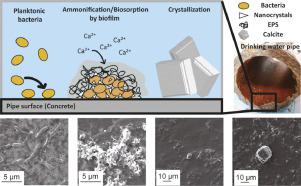Water Research ( IF 11.4 ) Pub Date : 2021-07-18 , DOI: 10.1016/j.watres.2021.117444 Xiaoxia Liu 1 , Gernot Zarfel 2 , Renata van der Weijden 3 , Willibald Loiskandl 4 , Brigitte Bitschnau 5 , Inez J T Dinkla 6 , Elmar C Fuchs 7 , Astrid H Paulitsch-Fuchs 8

|
Drinking water plumbing systems appear to be a unique environment for microorganisms as they contain few nutrients but a high mineral concentration. Interactions between mineral content and bacteria, such as microbial calcium carbonate precipitation (MCP) however, has not yet attracted too much attention in drinking water sector. This study aims to carefully examine MCP behavior of two drinking water bacteria species, which may potentially link scaling and biofouling processes in drinking water distribution systems. Evidence from cell density evolution, chemical parameters, and microscopy suggest that drinking water isolates can mediate CaCO3 precipitation through previously overlooked MCP mechanisms like ammonification or biosorption. The results also illustrate the active control of bacteria on the MCP process, as the calcium starts to concentrate onto cell surfaces only after reaching a certain cell density, even though the cell surfaces are shown to be the ideal location for the CaCO3 nucleation.
中文翻译:

饮用水细菌通过氨基酸代谢和生物吸附的密度依赖性微生物碳酸钙沉淀
饮用水管道系统似乎是微生物的独特环境,因为它们所含的营养素很少,但矿物质含量很高。然而,矿物质含量与细菌之间的相互作用,例如微生物碳酸钙沉淀(MCP),在饮用水领域尚未引起太多关注。本研究旨在仔细检查两种饮用水细菌物种的 MCP 行为,这可能将饮用水分配系统中的结垢和生物污染过程联系起来。来自细胞密度演变、化学参数和显微镜检查的证据表明,饮用水分离物可以介导 CaCO 3通过先前被忽视的 MCP 机制(如氨化或生物吸附)进行沉淀。结果还说明了 MCP 过程中细菌的主动控制,因为钙仅在达到一定的细胞密度后才开始集中到细胞表面,即使细胞表面被证明是 CaCO 3成核的理想位置。











































 京公网安备 11010802027423号
京公网安备 11010802027423号